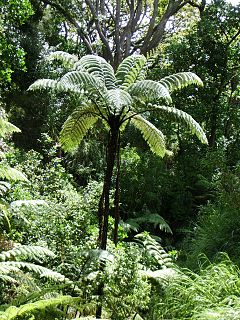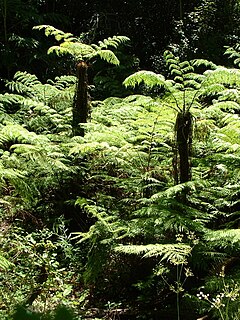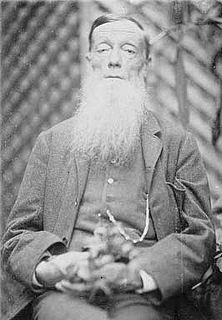
Cyathea medullaris, popularly known as the black tree fern, is a large tree fern up to 20 m tall. It is distributed across the south-west Pacific from Fiji to Pitcairn and New Zealand. It is called mamaku, katātā, kōrau, or pītau in the Māori language.
Cyathea affinis is a variable species of tree fern native to Fiji, Samoa, the Cook Islands, Austral Islands, Tahiti, and the Marquesas Islands. The trunk of this plant is erect and 2–6 m tall. Fronds are bipinnate and 2–3 m in length. The rachis and stipe are pale to brown in colour, or flushed with red towards the pinnule rachis. The stipe is sparsely covered in narrow basal scales, which are pale to dark and have broad fragile edges. Characteristically of this species, the lowest one or two pairs of pinnae may be slightly reduced and occur towards the base of the stipe. Sori are located near the pinnule midvein and are partially or fully covered by indusia, which open towards the pinnule margin.
Cyathea andersonii is a species of tree fern native to India, Bhutan and southern China, where it grows in moist valleys and montane forest at an altitude of 300–1200 m. The trunk is erect and 6–10 m tall. Fronds are bi- or tripinnate and 2–3 m long. The entire plant is relatively dark in appearance; the rachis is flushed with dark purple and the stipe is dark, almost to the point of being black. Dark, lanceolate scales with pale fringes are sparsely scattered along the length of the stipe. Sori occur near the midvein of fertile pinnules and lack indusia.
Cyathea archboldii is a species of tree fern native to New Guinea and Bougainville, where it is common in submontane rain forest at an altitude of 1000–3000 m. The trunk is erect and up to about 3 m tall. Fronds are bipinnate and 2–3 m long. The rachis may be purplish and has short spines and scales. The scales range in colour from pale to brown, to bicoloured and have fragile edges. Sori occur in two rows along each side of the pinnule midvein and are covered by firm indusia.
Cyathea atropurpurea is a species of tree fern native to the islands of Luzon, Mindanao, Leyte and Mindanao in the Philippines, where it grows in forest at above 1000 m. The erect trunk is slender and may be up to 3 m tall. Fronds are bipinnate and 1–2 m long. Characteristically of this species, the final pair of pinnae are usually reduced and occur towards the base of the stipe. These, along with the stipe bases, are persistent and retained around the trunk long after withering. The stipe itself is dark and covered with scales, which are either small, dull and brown or large, dark and glossy. Sori occur near the midvein of fertile pinnules and lack indusia. Fertile pinnules are notably smaller than sterile ones.

Cyathea brevipinna is a species of tree fern endemic to the higher parts of Mount Gower on Lord Howe Island, where it grows in exposed areas at an altitude of about 790 m. The trunk is erect and may reach 3 m in height. It is often covered with reddish brown scales and stipe bases. This species may produce stolons at ground level. Fronds are tripinnate, densely crowded, and up to about 3 m long. The stipe is brown and sometimes warty after scales fall off. The scales are long, glossy dark brown, with a distinctly narrow apex and fragile paler edges. Sori are attached to deeply divided fertile pinnules that may uncurl over the sori. Indusia are firm and large. C. brevipinna is a stunted plant with short pinnae.

Cyathea capensis is a regionally widespread and highly variable species of tree fern. It is indigenous to Southern Africa and South America.
Cyathea catillifera is a species of tree fern native to eastern New Guinea, where it grows in montane scrub at an altitude of about 2800 m and above. It is a rare plant, known only from the type locality. The erect trunk is up to about 1 m tall and 10 cm in diameter. Characteristically of this species, the trunk often branches at the base. Fronds are bi- or tripinnate, 1–2 m long and may bear a pair of reduced pinnae towards the base. There are usually around six live fronds per crown at any one time. The stipe is spiny, warty and pale on the upper surface to dark at the base. It is |covered with scattered basal scales that are glossy dark brown and have a paler margin. Stipes are persistent with bases retained on the trunk. Sori occur near the midvein of fertile pinnules and are covered by thin, brown indusia that are saucer-like in appearance.

Cyathea colensoi, also known as the Creeping Tree Fern, Mountain Tree Fern and Golden Tree Fern, is a species of tree fern native to New Zealand, from the southern part of the North Island south to Stewart Island. It grows in submontane to montane forest in damp areas, particularly near the tree line. The trunk is usually prostrate, but may sometimes be erect. It may reach about 1 m in height. Fronds are tripinnate and about 1.5 m long or more. The rachis and stipe are slender, pale brown and are covered with brown scales. Sori occur in two rows, one along each side of the fertile pinnule midvein, and lack indusia. Plants form a thicket with no sign of a trunk.

Cyathea cunninghamii, also known as the gully tree fern and slender tree fern, is a species of tree fern indigenous to New Zealand including North Island, South Island and Chatham Islands; also to Victoria, possibly New South Wales, southeastern Queensland and Tasmania in Australia. It grows in damp forest, often emerging from stream gullies and riverbanks. Brownsey noted that it has a lower tolerance for drought than other species of Cyathea. The erect trunk may be 20 m tall and is usually 6–15 cm in diameter, occasionally as much as 20 cm. Fronds are tri- to tetrapinnate and 3 m or more in length. The rachis and stipe are slender, black brown, warty and covered with brown scales. Sori occur along each side of the pinnule midvein and are covered by hood-like indusia. C. cunninghamii is an uncommon and slow-growing tree fern.
Cyathea deckenii is a species of tree fern native to the Democratic Republic of the Congo, Tanzania and Mozambique, where it grows in wet forest at an altitude of 1350–2300 m. The trunk is erect and up to 10 m tall. Fronds are bipinnate and 2–3 m long. Characteristically of this species, the most basal one or two pairs of pinnae are reduced. The rachis and stipe range in colour from brown to dark brown or black-brown and are sparsely covered with a few scales. The scales are dark and narrow with a fragile margin of variable width. The stipe also has conical warts near the base. Sori are round and covered by large, thin indusia.

Cyathea dregei is a widespread species of tree fern in southern Africa.
Cyathea recommutata is a species of tree fern native to the Malay Peninsula, central and southern Sumatra and Borneo, where it grows in acidic peaty or sandy soils in wet forest, as well as swamp forest, from sea level to an altitude of 1500 m. The trunk is erect and rarely taller than 3 m. Fronds are bipinnate and 1–2 m long. Characteristically of this species, the lowest pair of pinnae are usually reduced and occur towards the base of the stipe. The stipe itself is dark dark and bears dark, glossy basal scales with thin, fragile edges. Fertile pinnules are notably smaller than sterile ones. Sori occur near the fertile pinnule midvein and lack indusia.
Cyathea foersteri is a species of tree fern native to eastern New Guinea, where it grows in scrub in forest margins and mossy forest at an altitude of 1600–2800 m. The trunk is erect and up to 10 m tall. Fronds may be bi- or tripinnate and 2-2.5 m long. Usually around nine or ten live fronds are present in the crown at once. The stipe is covered in pale scales. Sori occur near the fertile pinnule midvein and are protected by firm, thin indusia.
Cyathea glabra is a species of tree fern native to Borneo, western Java, Sumatra and the Malay Peninsula, where it grows in lowland swamp forest and montane forest at an elevation of up to 1500 m. The trunk of this plant is erect and 2–4 m tall. Fronds are bi- or tripinnate and 1–2 m in length. Characteristically of this species, the lowest pinnae may be significantly reduced. The stipe is very dark and bears basal scales. These scales are dark, glossy and have a paler margin and fragile edges. Sori are produced in groups of one to three on fertile pinnule veins. They lack indusia.
Cyathea grevilleana is a species of tree fern endemic to Jamaica, where it grows in moist gullies and on wooded hills in both calcareous and noncalcareous soils at an altitude of 200–1200 m. The trunk of this plant is erect, about 7 m tall, and 10–15 cm in diameter. It is characteristically clothed in old stipe bases, brown scales and blackish spines. Fronds are tripinnate, dark green in colour, and up to 4 m in length. The last pinnae are sometimes separated, forming a distinctive clump around the trunk apex. The rachis is yellow-brown and almost smooth. This species has a long, dark brown stipe with a few scattered spines. Sori are produced in four to six pairs along the pinnule midvein. They are protected by pale brown indusia that are cup-like in appearance.
Cyathea hancockii is a species of tree fern native to the Ryukyu Islands, Japan, Taiwan and Hong Kong. The specific epithet hancockii commemorates William Hancock (1847-1914), who collected numerous plants in Japan, China and Southeast Asia. It grows in forest, on stream banks, and in forest margins at an elevation of about 600 m or higher.
Cyathea × marcescens, commonly known as the skirted tree fern, is a tree fern endemic to the Cape Otway ranges in Victoria and Tasmania, Australia. It is a natural hybrid, apparently Cyathea australis × Cyathea cunninghamii. Braggins and Large (2004) note that it has characteristics midway between these two species. The spores of C. × marcescens are usually malformed although sterile. The trunk of this plant is erect and up to 10 m tall. Fronds may be bi- or tripinnate and 3–4 m in length. Dead fronds often persist, forming a characteristic skirt around the trunk. The stipe is thick, black and warty. The rachis and trunk are covered in shiny, dark brown scales. Sori are borne near the fertile pinnule midvein and are protected by thin indusia that are saucer-like in appearance.
Cyathea hornei is a species of tree fern. Its natural distribution covers eastern New Guinea and the Louisiade Archipelago to Fiji, where it grows in wet submontane forest, stunted forest, mossy forest, and on ridges, at an altitude of 400–2000 m. The trunk of this plant is erect, 3–4 m tall and up to about 4 cm in diameter. Fronds may be pinnate or bipinnate and reach a length of 2 m. Basal scales cover the dark rachis and stipe of this species. These scales are glossy and either bicoloured or light brown and bullate. Sori almost cover the lower segments of fertile pinnules. Indusia are absent.
Cyathea junghuhniana is a species of tree fern native to southern and central Sumatra and western Java, where it grows in forest at an altitude of 1000–2000 m. The trunk of this species is erect and may be 2 m tall or more. Fronds are tripinnate and up to about 3 m long. The stipes of this species are persistent and form a skirt around the trunk. They are brown, spiny, and covered with glossy, dark brown scales. Sori are borne near the midvein of fertile pinnules and are protected by thin indusia.











